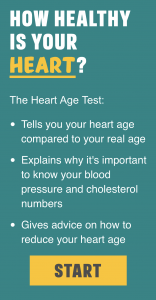 ‘Heart Age’ calculators might be useful communication tools around lifestyle change to reduce cardiovascular risk but they could also lead to overtreatment of people at low risk of heart attack or stroke, experts warn.
‘Heart Age’ calculators might be useful communication tools around lifestyle change to reduce cardiovascular risk but they could also lead to overtreatment of people at low risk of heart attack or stroke, experts warn.
While popular and being promoted in countries such as the UK, the tools are more likely to create anxiety in otherwise healthy individuals and do not match with validated measures of absolute cardiovascular risk.
And the Heart Age calculators have recently been ridiculed on social media by doctors who have been baffled by the inconsistent results they have obtained (see below).
In a recent issue of BMC Cardiovascular Disorders, a group of Australian epidemiologists, clinicians, psychologists and behavioral scientists criticised the use of calculators such as the UK’s NHS 16-item How healthy is your heart?
The tool includes questions on risk factors such as age, gender, smoking, blood pressure, cholesterol, overweight/obesity and comorbidities.
However the different risk thresholds used by various heart age calculators mean the same person could receive several different recommendations, the Aussies said.
So despite having a BMI of 19.7 and no risk factors my heart age is put at 49. I am 47. Why? Because I haven’t had my BP or cholesterol checked? What nonsense.
— Sally Lewis (@RslewisSally) September 5, 2018
And having a heart age older than chronological age, especially for younger people, does not necessarily mean an individual is at risk of a CVD event in the next 5-10 years.
“Motivating patients with CVD risk factors to change their lifestyle is important at any age, and this is where the heart age concept has been promoted as a potentially useful tool,” they said.
“Clinical trials have shown that paper-based and online risk assessments that include heart age can be beneficial and improve risk factor management compared to standard care with verbal counselling about absolute risk.”
However heart age should not be used to inform decision-making about medications such as statins and anti-hypertensives.
“There are now multiple heart age calculators linked to clinical practice guidelines and available to the public, conveying conflicting messages about risk and medication. It is essential that doctors and patients understand the assumptions behind these heart age calculators and how they relate to absolute risk-based medication guidelines.”
“To make an informed decision about medication, patients need to understand their baseline absolute risk, because the probability of preventing CVD with treatment is directly proportional to this.”
Co-author Professor Paul Glasziou, director of the Centre for Research in Evidence-Based Practice at Bond University, told the limbic the calculators were calibrated against the lowest possible risk – effectively making everybody’s heart age older than their actual age.
“It creates an inappropriate anxiety in the population that is unnecessary and may drive people towards inappropriate behaviours.”
“It’s not a good communicator of whether you’ve got a serious problem or not and people are over interpreting it.”
He said he suspected the initiative was driven by sincere intent however.
“People think this will be motivating to get people to do something about lowering their risk. But there is a downside in worrying the well and leaving them worried and not getting to the sicker people who actually need something done.”
“And unless you’ve done the studies to show there is a net benefit then labeling people is not actually a good thing for the population. You may be harming people by trying to do good.”
The biggest risk was in lowering the threshold for medication and over-treating some people.
“National estimates of heart age by government health organisations in the US, UK and China show how this approach could lead to ‘mass medicalisation’, as the majority of the general population has an older heart age than current age,” they said in the article.
“Informed medication decisions should be based on absolute risk and benefit rather than heart age, and evidence-based communication formats such as decision aids should be used to avoid uninformed decision making and overtreatment of healthy, asymptomatic people who are at low risk of a heart attack or stroke.”